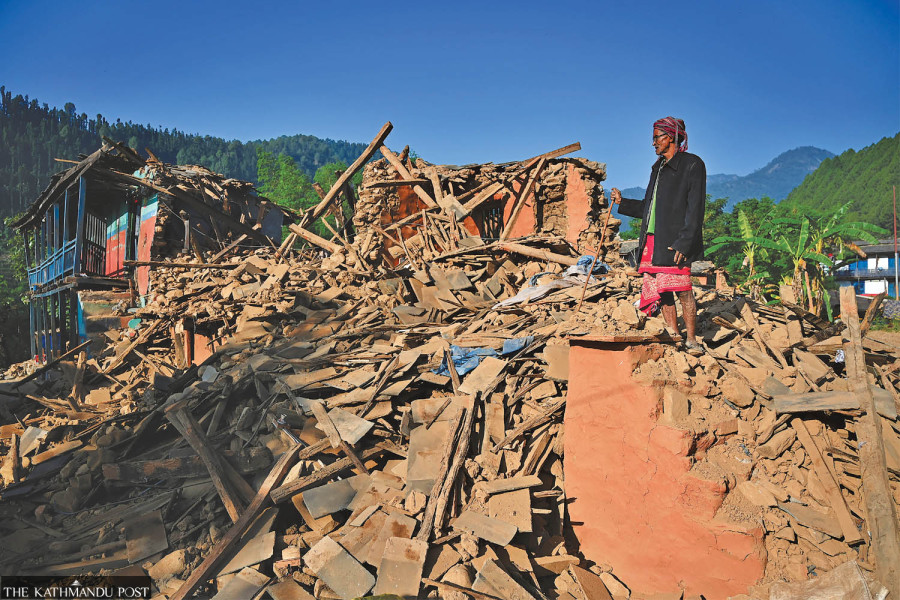Health
Preventing disease outbreaks a challenge in the quake’s wake
At least 157 people died, hundreds were injured and thousands displaced in the M6.4 earthquake that rocked Jajarkot and West Rukum of Karnali Province on Friday night.
Arjun Poudel
Preventing possible outbreaks of communicable diseases—water-borne and vector-borne—is the main challenge in the areas hit hard in Friday night’s earthquake.
At least 157 people died, hundreds were injured and thousands were displaced by the magnitude 6.4 earthquake that rocked Jajarkot and West Rukum of Karnali Province.
The earthquake's epicentre was Ramidanda of Jajarkot, according to the National Seismological Centre.
There are only five patients at the district hospital and around 15 at the primary hospital at Nalgad Municipality, according to the Health Office Jajarkot. They said most of the injured have already been discharged or referred to major hospitals in Nepalgunj and Kathmandu.
Preventing possible outbreaks in the coming days will be challenging, as people are forced to live in the open amid growing chill, Krishna Bahadur Khatri, information officer at the Health Office Jajarkot. “An outbreak of communicable diseases—cold-related ailments and waterborne diseases—is likely in the coming days due to falling temperatures and damaged infrastructure.”
Along with houses, toilets were also destroyed in the quake. Officials say the destruction of toilets increases open defecation, which risks contamination of water sources. The risk of vector-borne diseases—malaria, dengue, kala-Azar and scrub typhus among others—spreading also increases, according to experts.
Nepal saw a surge in scrub typhus cases after the 2015 earthquakes, which killed nearly 9,000 people. Three months after the twin earthquakes, the BP Koirala Institute of Health Sciences, Dharan had alerted the Epidemiology and Disease Control Division on six cases of children with unusual fever and severe respiratory features.
Over 4,000 people have been infected with the disease since January this year.
At least 105 people died in the quake in the district and 41 others severely injured have been referred to hospitals in Nepalgunj and Kathmandu. One of the critically injured victims was reported dead at a Nepalgunj health facility.
Health workers say they had no problem providing treatment, as the number of patients seeking care was “very few” on Sunday.
“Teams of medics from the provincial health office, other provinces and centres have been mobilised in the affected areas,” said Khatri. “We have sufficient medicines and health workers at present, but the help of additional health workers may be needed in the coming days as the risk of disease outbreaks will be high.”
Jajarkot witnessed the worst diarrhoea outbreak in 2009, in which 111 people died and over 6,000 were infected. In 2016 too, an outbreak of cholera was recorded in the said district.
Officials at the Rukum West Health Office said no more health workers are needed in the quake-hit areas, as district and provincial offices have deployed in sufficient numbers.
“We sent back a team of health workers who arrived here from Dang today,” Kali Bahadur Oli, information officer at the Health Office, West Rukum. “We may need the help of health workers in the coming days but not now.”
According to Oli, his office discussed possible outbreaks in the coming days with officials at the district disaster management committee and other agencies concerned.
“Along with outbreaks of communicable diseases, small children, pregnant women and elderly people will be at risk of malnutrition,” said Oli. “Infections and the cold affect the most vulnerable first.”
Most of the displaced people are spending nights in the open. Officials said they were trying to send tarpaulin tents and relief materials at the earliest, but locals complain that the tarps aren’t much help in the winter cold.
Most houses in the highly affected areas have sustained damage. The jolts have created fissures, making houses unlivable, according to Oli.
Meanwhile, health ministry officials concede that the risk of outbreaks of waterborne and vector-borne diseases and viral infections escalates in the aftermath of a disaster. Diarrheal outbreaks were recorded after the 2015 Gorkha earthquake.
“We are aware of the risk and have alerted agencies concerned,” said Dr Prakash Budhathoky, spokesperson for the health ministry. “Safe drinking water, hygiene and sanitation, and nutritious food to the affected people will be crucial in the aftermath of a disaster. We are also coordinating with the Ministry of Home Affairs to provide warm clothes to the displaced.”




 8.12°C Kathmandu
8.12°C Kathmandu













%20(1).jpg&w=300&height=200)
